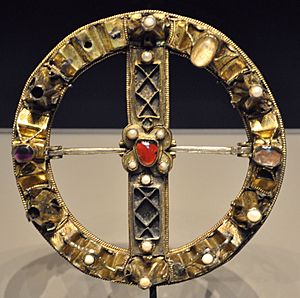Glen Lyon facts for kids
Glen Lyon (Scottish Gaelic: Gleann Lìomhann) is a long valley in Scotland. It is found in the Perth and Kinross area. This glen is special because it is the longest enclosed valley in Scotland! It stretches for about 34 miles (55 kilometers) from Loch Lyon in the west to the village of Fortingall in the east.
Long ago, people sometimes called it An Crom Ghleann, which means "The Bent Glen." It is part of a beautiful area called the Loch Rannoch and Glen Lyon National Scenic Area. This area is protected to keep its amazing scenery safe from too much building. A famous writer, Sir Walter Scott, once said Glen Lyon was the "longest, loneliest and loveliest glen in Scotland."
You will find only a few scattered farms and cottages in the glen. The main villages are Fortingall and Bridge of Balgie. Glen Lyon also has a small primary school where children learn Scottish Gaelic every week.
History of Glen Lyon

People have lived in Glen Lyon for a very long time, even since prehistoric times. Many old archaeological sites show this. Today, not as many people live there, but it has been home to many important Scottish families, called Scottish clans. These include the MacGregor, Lyon, Menzies, Stewart, Macnaughtan, MacGibbon, and Campbell clans.
Around the end of the 11th century, a family called the de Leons came to Scotland. They helped Prince Edgar win a battle. Because of their help, they were given lands that later became known as Glen Lyon.
A local leader named Robert Campbell of Glenlyon (who lived from 1630 to 1696) was involved in a sad event in Scottish history. He led soldiers during the Glencoe Massacre in 1691, which affected the MacDonald clan.
A beautiful silver and gold brooch that belonged to the Campbell leaders of Glen Lyon is now in the British Museum. This brooch is very old, dating back to the early 1500s.
Glen Lyon has also been home to early Christian monks, like Adomnán (who died in 704). He was an important religious leader and wrote about St Columba. The glen also has two castles: Meggernie Castle, which people still live in, and Carnbane Castle, which is now in ruins.
Famous People from Glen Lyon
Many interesting people have connections to Glen Lyon:
- Isobel Forrester was born in Glen Lyon in 1895. She became known for her work in bringing different Christian churches together.
- Father James MacGregor (Scottish Gaelic: Maighstir Seumas MacGriogair) was a priest in Fortingall in the early 1500s. He put together a very important book called the Book of the Dean of Lismore. This book is the best collection of old Scottish Gaelic writings that we still have today. He also wrote a diary about local events, which helps us learn about the history of the central Scottish Highlands.
- Watson Kirkconnell (1895-1977) was a Canadian poet and thinker. He was very proud of his Scottish family roots from Glen Lyon. He wrote about his ancestors in his own life story.
Gallery




